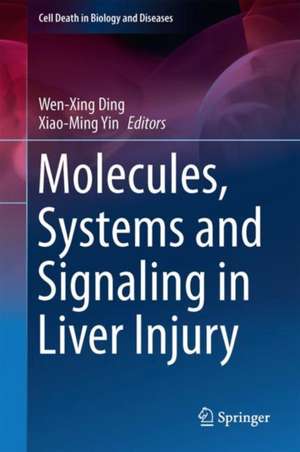Molecules, Systems and Signaling in Liver Injury: Cell Death in Biology and Diseases
Editat de Wen-Xing Ding, Xiao-Ming Yinen Limba Engleză Hardback – 14 aug 2017
es, Systems and Signaling in Liver Injury is an essential companion to Hepatocytes and Non-Parenchymal Cells and Diseases. It is beneficial for both clinicians and basic scientists and is relevant to those working on drug discovery for preventing and treating liver diseases by targeting cell death and autophagy pathways.
| Toate formatele și edițiile | Preț | Express |
|---|---|---|
| Paperback (1) | 784.37 lei 38-44 zile | |
| Springer International Publishing – 12 aug 2018 | 784.37 lei 38-44 zile | |
| Hardback (1) | 951.14 lei 6-8 săpt. | |
| Springer International Publishing – 14 aug 2017 | 951.14 lei 6-8 săpt. |
Preț: 951.14 lei
Preț vechi: 1159.94 lei
-18% Nou
Puncte Express: 1427
Preț estimativ în valută:
182.02€ • 197.65$ • 152.90£
182.02€ • 197.65$ • 152.90£
Carte tipărită la comandă
Livrare economică 23 aprilie-07 mai
Preluare comenzi: 021 569.72.76
Specificații
ISBN-13: 9783319581057
ISBN-10: 3319581058
Pagini: 406
Ilustrații: XV, 290 p. 25 illus., 20 illus. in color.
Dimensiuni: 155 x 235 mm
Greutate: 0.61 kg
Ediția:1st ed. 2017
Editura: Springer International Publishing
Colecția Springer
Seria Cell Death in Biology and Diseases
Locul publicării:Cham, Switzerland
ISBN-10: 3319581058
Pagini: 406
Ilustrații: XV, 290 p. 25 illus., 20 illus. in color.
Dimensiuni: 155 x 235 mm
Greutate: 0.61 kg
Ediția:1st ed. 2017
Editura: Springer International Publishing
Colecția Springer
Seria Cell Death in Biology and Diseases
Locul publicării:Cham, Switzerland
Cuprins
1.Lipotoxicity in non-parenchymal liver cells.- 2.The Role of Cholangiocyte Cell Death in the Development of Biliary Diseases.- 3.Cell Death and Autophagy in Hepatic Stellate Cell Activation and Function.- 4.The Switch: Mechanisms Governing Macrophage Phenotypic Variability in Liver Disease.- 5.Regulation of apoptosis by Bcl-2 family proteins in liver injury.- 6.Beta-Catenin And The Survival Of Hepatocytes.- 7.Nuclear DAMPs in Hepatic Injury and Inflammation.- 8.The Critical Role of Mitochondria in Drug-Induced Liver Injury.- 9.Mitochondrial Damage and Mitophagy in Ischemia/Reperfusion-Induced Liver Injury.- 10.Role Of Endoplasmic Reticulum Stress In Hepatic Injury.- 11.The Impact Of Gut Microbiota On Liver Injury.
Notă biografică
Dr. Wen-Xing Ding is an Associate Professor of Department of Pharmacology, Toxicology and Therapeutics at The University of Kansas Medical Center. He received his Ph.D. from the National University of Singapore. He did his Postdoctoral training at University of Pittsburgh. In the past decade, Dr. Ding’s research has been focused on the molecular mechanisms of cell death and autophagy in alcohol and drug-induced liver injury as well as liver tumorigenesis. Dr. Ding is a member of American Association of Studies of Liver Disease (AASLD), Society of Toxicology (SOT) and Research society of Alcoholism. Dr. Ding was a Liver Scholar of American Liver Foundation and a recipient of University Scholarly Achievement Award. Dr. Ding has published more than 100 papers in peer-reviewed journals and his research work is currently supported by NIAAA and NIDDK.
Dr. Xiao-Ming Yin is the Louis Y. Mazzini Professor of Pathology at the Department of Pathology and Laboratory Medicine,
Indiana University School of Medicine. He obtained his medical degree from Shanghai Medical University and his PhD degree from University of Texas Southwestern Medical Center at Dallas. He completed his post-doctoral fellow training and his pathology residency training at Washington University in St. Louis. Dr. Yin is a member of several scientific societies and is a fellow of American Association of Studies of Liver Disease (AASLD). He has won the Outstanding Investigator Award from American Society for Investigative Pathology (ASIP). His research interest is the cell death and survival in tissue injury and cancer biology, particularly in the liver system.
Dr. Xiao-Ming Yin is the Louis Y. Mazzini Professor of Pathology at the Department of Pathology and Laboratory Medicine,
Indiana University School of Medicine. He obtained his medical degree from Shanghai Medical University and his PhD degree from University of Texas Southwestern Medical Center at Dallas. He completed his post-doctoral fellow training and his pathology residency training at Washington University in St. Louis. Dr. Yin is a member of several scientific societies and is a fellow of American Association of Studies of Liver Disease (AASLD). He has won the Outstanding Investigator Award from American Society for Investigative Pathology (ASIP). His research interest is the cell death and survival in tissue injury and cancer biology, particularly in the liver system.
Textul de pe ultima copertă
This essential volume presents comprehensive information on cell death and autophagy in liver diseases, including the role and molecular signaling pathways of cell death in alcohol and non-alcoholic fatty liver disease, bile acids, hepatitis C virus and drug-induced liver injury. The book starts with a discussion of lipotoxicity in non-parenchymal cells, followed by a discussion of cell death and autophagy in cholangiocytes, hepatic stellate cells and Kupffer cells in hepatic biliary diseases, fibrosis and liver inflammation. The book also covers Bcl-2 family proteins, beta-catenin and HMGB1 signaling in regulating cell death in the liver as well as mitochondria, ER stress and gut microbiota on liver injury. The Cell Death in Biology and Diseases series has recruited world experts ranging from basic scientists to clinicians on cell death in liver diseases. Likewise the contributors of this volume are leaders in their fields with worldwide expertise and perspective. Molecules,Systems and Signaling in Liver Injury is an essential companion to Hepatocytes and Non-Parenchymal Cells and Diseases. It is beneficial for both clinicians and basic scientists and is relevant to those working on drug discovery for preventing and treating liver diseases by targeting cell death and autophagy pathways.
Caracteristici
Provides thorough, comprehensive discussion of the topic with enough breadth to appeal to scientists, clinicians and those doing research for drug discovery Contributors contribute worldwide expertise and perspective and are all leaders in their fields Illustrations and tables throughout enhance and complement the text




